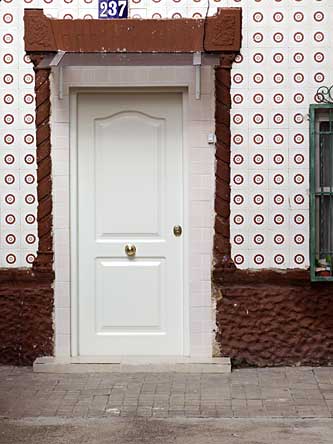It seems as though the city government has plans to extend a huge boulevard through the historic Valencian neighborhood of Gran Via. Over 400 buildings will be torn out of the ground and the area left unrecognizable.
Oh… wait a second. Gran Via is the home of Valencia’s wealthy elite, and the destruction of their neighborhood to improve transit would be absolutely unthinkable. I must have my facts wrong… let’s see…
Ah yes, here it is. It’s the historic neighborhood of Cabanyal which is to be gutted for the extension of Boulevard Blasco Ibáñez. The Ayuntamiento is planning to rip up hundreds of apartments, in order to speed access to the sea. Yes, yes, all in the name of progress. Only poor people actually live in Cabanyal, so who cares?
Turns out a lot of people do. Cabanyal is one of Europe’s most unique and important seaside neighborhoods. The battle over its future has been going on for about a decade. Recently, further development has been blocked by the Spanish Ministry of Culture, which recognized Cabanyal as a site of cultural heritage.
As you can guess from the tone of my writing, I’m opposed to the extension of Blasco Ibáñez. In the past, it’s been suggested that I “keep my mouth shut” on political matters, since I’m a foreigner. But tough. Especially because I’m a visitor, I’m well aware that the historic district of Cabanyal is one of the city’s top highlights. The government doesn’t seem to recognize the treasure right under its nose. They should be restoring the neighborhood, not destroying it.
Events in and around Cabanyal: Semana Santa – Beach Procession – Mascleta Napolitana

Of course you can express your opinion, Especially because you are a visitor who knows Valencia better than many valencians!!
The discussion about Boulevard Blasco Ibañez (former Paseo Valencia al Mar, i.e, Boulevard of “Valencia to the sea” 😉 started 117 years ago. I recommend to read a about the history here: http://bit.ly/6qo6tq (in Spanish)
The current plan is not perfect, but it has many advantages for the preservation of the Cabanyal itself. Only affects to 2% of the houses. And the remaining 98% will gain. Read here: http://bit.ly/5ESdCt
You can walk the area, physically, or virtually thanks to Google Streetview http://bit.ly/5rbAGc
I don’t think it’s a bad plan. The better part of Cabanyal is not to be touched, only a part with rather new (and thus far from classical) housing will be torn down, which are mostly ruins already. I’m also pretty sure it’s 400 flats, not buildings. It will be a great opportunity to open up Cabanyal for the visitors. I actually live in Cabanyal, btw.
Most visitors would take public transportation. Maybe they should start with extending the metro all the way to the port/beach!
It’s a very controversial question. Cabanyal’s character lies on its well preserved urban structure, which will obviously be destroyed with the planned extension of the wide Blasco Ibanez Boulevard.
There is a similar case in Ottensen, a neighbourhood in the german city of Hamburg. In fact, there is a partnership between Cabanyal and Ottensen.
Have a look at http://cabanyal-ottensen.blogspot.com/
Only poor people actually live in Cabanyal
If by poor people you mean a large majority are drug users/dealers, prostitutes and various other squatter-types who contribute nothing (or less) to society, then, yes, that´s true. It´s basically just a suburb of “Casitas Rosa.”
I´ve seen a lot of coastal towns, but not many compare to the ****holes I´ve seen along the coast of Valencia. Much of the economy here is driven by tourism, as you know, and much more could be gained if that giant stretch (and others like it) of the city´s coastline didn´t look like a bomb dropped on it 100 years ago and is now only home to the roaches of Valencia (thanks to the government´s tough approach to law enforcement).
Sure, some of those houses are old and have quaint looking tiles on their façades, but, guess what, they´re unfit to live in and should have been refurbished long ago. It would cost the city a massive fortune to restore them now. So, between tearing through the ugliest part of an already ugly area to bring tourists to where they want to go easier and without feeling like they´ll be risking their lives to do it (with the benefit of guaranteed almost instant revenue generation), and spinning their wheels for the next decade or more trying to figure out how to make a restoration project even work (and one that would inevitably only benefit a small fraction of wealthy investors and construction companies through some back-room deal anyway), I don´t think it was really that tough a decision to come to; and one of few I´ve heard of here that actually make any sense at all.
If it´s the poor you´re worried about, start delving more into the government policies that allow these slums to exist in the first place; that´s the core of the problem.
It’s quite interesting to see that the people that think of being progressivist, are the most conservationist…
Paris will not be the grand city that is today if Haussmann hadn’t “destroy” some districts to create the big boulevards, same in Barcelona and by the way the progres didn’t complain when their local government “destroyed” the Barceloneta to create the nice cost line they have today…